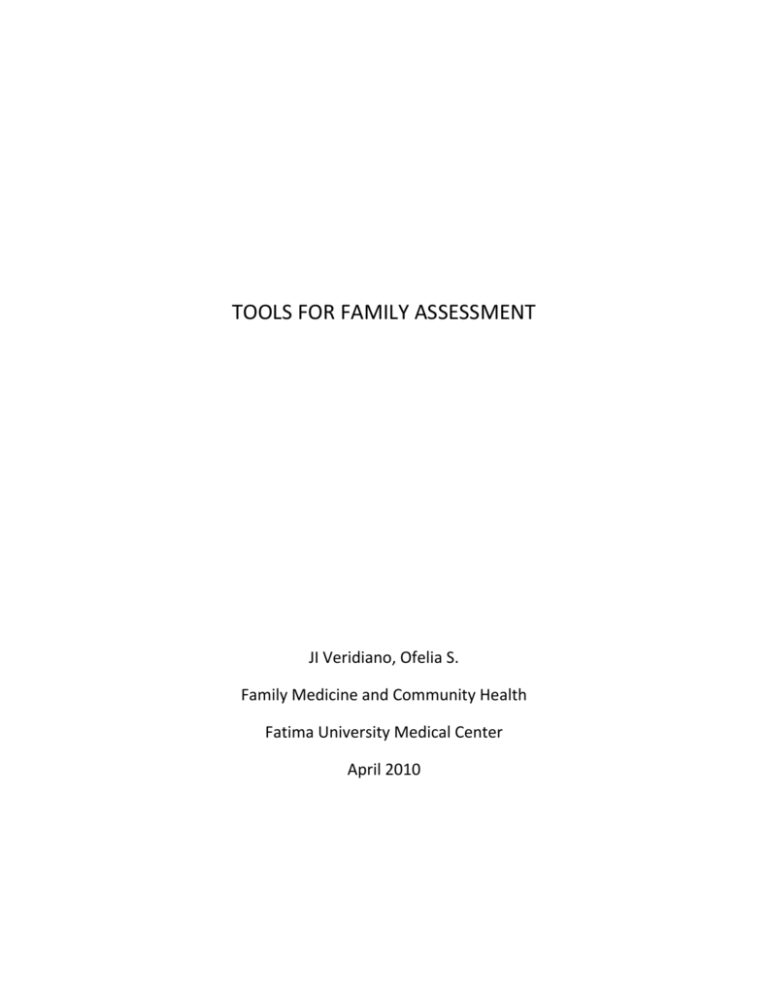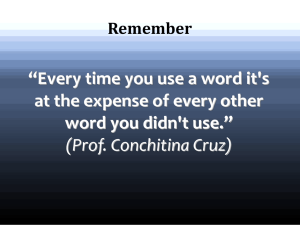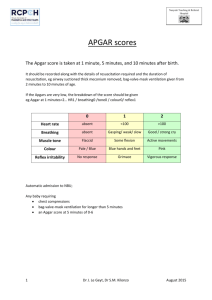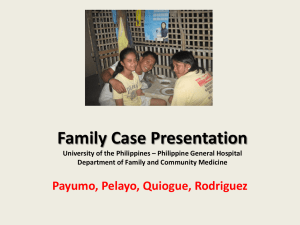Economic
advertisement

TOOLS FOR FAMILY ASSESSMENT JI Veridiano, Ofelia S. Family Medicine and Community Health Fatima University Medical Center April 2010 Introduction Every patient that we encounter is a member of a family and a physician must always keep in mind that the way a patient reacts to an illness will depend a lot on his family. Several investigators have hypothesized that in treating a patient, one must treat also the family as a unit to yield a more certain diagnosis, a better medical outcome, and even prevent diseases. With this, it will depend on the family physician as to up to what level he will involve a patient’s family to evaluate his problem. Overview of Family Systems Medicine As a family physician, one must always view a patient’s problem in multiple context meaning that one does not only consider the pathophysiology of a certain disease but should also consider and evaluate family relationships, family social and cultural systems to provide better health care. This is the primary goal of Family Systems Medicine which will lead to a better understanding of a patient’s condition. Incorporating a Family Systems Approach into Clinical Practice To be able to incorporate a family systems approach into clinical practice, the family physician must be able to understand first the basic concepts of family structure and function. This is a three-step process which is as follows: Step 1- RECOGNIZE THE FAMILY STRUCTURE In order to understand the family, one must first know the individual members of it. The following information must be obtained: names of each family member, place of residence, specific roles in the family, stage of the family in the family life cycle, and significant dates in the family. A systematic way of obtaining and recording this information is through the use of a Family Genogram which is a scheme or a graphic representation of both the genetic pedigree of a family and key psychosocial and interactional data using standardized symbols. a. Family Tree - Must consist of 3 or more generations with each generation identified by Roman numerals - The first born of each generation is farthest to the left with the following siblings going to the right according to order of birth - Family name is placed above each major family unit - Names and ages written below the symbol - Index patient is identified with an arrow - Date must be indicated when it was made to be able to adjust the ages over time b. Functional Chart It gives a more dynamic image of the family especially the relationship of each member to other members. This allows one to judge the family’s totality as a unit, its strengths and weaknesses, and its adaptability in future stressful situations c. Family Illness/History This indicates the presence of heredofamilial diseases in which potential problems in the family can arise. Step 2- UNDERSTAND THE NORMAL FAMILY FUNCTION The 5 basic family functions are: 1. Provide support to each other - Can be in the form of physical, emotional, social, or financial - There is a sense of belongingness when family members do things together as one 2. Establish autonomy and independence for each person in the system to enhance personal growth of individuals within the family - Each individual has defined roles to play within and outside the family - The essence of autonomy is to be able to maintain the integrity of each individual 3. Create rules that govern the conduct of the family and of individuals within it - Deals with interaction patterns, authority, and decision-making - These are mostly unwritten rules of behaviors that becomes apparent when an outsider visits the family 4. Adapt to change in the environment - Essential in order to progress from one stage of the family life cycle to another - There are two types of changes: First order and Second order - The first order change involves adaptation to environmental changes that requires minimal change in the family structure - The second order change involves fundamental changes in the family structure 5. Communicate with each other - Mostly verbal, non-verbal, and implied messages FUNCTIONAL FAMILY- is defined as a family wherein a balance between these functions is achieved. Imbalances may result from over or under emphasis of these functions. DYSFUNCTIONAL FAMILY- defined as a family with chronic inability to respond to the needs or to cope with changes and stresses in the environment Step 3- LEARN TO ASSESS FAMILY STRUCTURE AND FUNCTION IN CLINICAL PRACTICE It has been the standard medical practice to meet the family as a unit in instances when a patient is rushed to the emergency room with a life-threatening condition, a patient with a chronic illness, and even death of a family member. Oftentimes the family physician is unprepared to assemble family members for assessment. Thus, family assessment tools have been made to aid the family physician in assessing the family structure and function in clinical practice. Family Assessment Instruments 1. 2. 3. 4. 5. 6. 7. 8. Family Genogram Family Circle Family APGAR FACES (Family Adaptability and Cohesion Evaluation Scale) FES (Family Environmental Scale) Clinical Biography and Life Events SCREEM DRAFT (Draw A Family Test) FAMILY GENOGRAM A family genogram is a graphic representation of a family tree that displays detailed data about the relationships among individuals in a family. It goes beyond the traditional family tree by allowing the user to analyze hereditary patterns and psychological factors that punctuate these relationships. Genograms allow a therapist and his patient to quickly identify and understand various patterns in the patient's family history which may have had an influence on the patient's current state of mind. It also maps out relationships and traits that may otherwise be missed on a pedigree chart. The family genogram is an excellent tool to learn about the family structure but has limited role in assessing the family functions. It contains the following informations: 1. Names, gender, date of birth, date of death, and roles of each family member 2. Divisions of an extended family into several households 3. Medical problems and chronic illnesses of each family member 4. Significant dates in the family history 5. Subtle information about the family 6. Nature of the family relationships Genograms can vary significantly because there is no limitation as to what type of data can be included. FAMILY CIRCLE Family circles are often used on individuals and in some small groups. A large circle is drawn by the family physician on a piece of paper who then gives instructions to the patient to look at the circle as if it is his family and then draw small circles to represent the patient and those people who are important to him. The circles can be small or large depending on the person’s significance or importance to the patient. An advantage of this tool is that the physician can leave the patient to accomplish this and see other patients. But because this is subjective, difficulty of interpretation and standardization poses as a disadvantage. Dex Mama Pesh Mama chuchi Arra Rihanne Me Ja Kuya Nel Chok Erin FAMILY APGAR Ate Tere This is a 5-question assessment tool used for rapid assessment of family function and dysfunction. It measures an individual’s level of satisfaction about family relationships. As this is only a 5-item questionnaire, it requires little time to complete. APGAR stands for: Adaptation- the ability of a family to use and share inherent resources which can be either intra- or extra-familial Partnership- the sharing of decision making which measures the satisfaction of solving problems through communicating Growth- pertains to both physical and emotional aspects and measures the satisfaction of the freedom to change Affection- emotions that are shared with and between family members which measures the satisfaction with the intimacy and emotional interaction that exist in the family Resolve- refers to how time, money, and space are shared; this measures the satisfaction with the commitment made by members of the family There are 4 basic situations wherein the Family APGAR is needed: 1. When the family is directly involved in caring for the patient. 2. When treating a new patient in order to get information to serve as general view of family function 3. When treating a patient whose family is in crisis. 4. When a patient’s behavior makes you suspect a psychosocial problem possibly due to family dysfunction. FAMILY APGAR QUESTIONNAIRE PART I Part I- Helps define the degree of the patient’s satisfaction or dissatisfaction with family function Almost Some always of (2) the time (1) Hardly ever (0) A I am satisfied that I can turn to my family for help when something is troubling me. P I am satisfied with the way my family talks about things with me and shares problems with me. G I am satisfied that my family accepts and supports my wishes to take on new activities or directions. A I am satisfied with the way my family expresses affection and responds to my emotions such as anger, sorrow, and love. R I am satisfied with the way my family and I share time together. FILIPINO FAMILY APGAR QUESTIONNAIRE PART I Sagutin ang mga sumusunod ayon sa relasyon ninyong mag-anak Palagi (2) A Ako’y nasisiyahan dahil nakakaasa ako ng tulong sa aking pamilya sa oras ng problema. P Ako’y nasisiyahan sa paraang nakikipagtalakayan sa akin ang aking pamilya tungkol sa aking problema. G Ako’y nasisiyahan at ang aking pamilya ay tinatanggap at sinusuportahan ang aking mga nais na gawin patungo sa mga bagong landas para sa aking ikauunlad. A Ako’y nasisiyahan sa paraang ipinadadama ng Paminsanminsan (1) Halos hindi (0) aking pamilya ang kanilang pagmamahal at nauunawaan ang aking damdamin katulad ng galit, lungkot, at pag-ibig. R Ako’y nasisiyahan na ang aking pamilya at ako ay nagkakaroon ng panahon sa isa’t-isa. FAMILY APGAR part II- Delineates relationships with other members, identifies persons who can give assistance to the patient, and indicates conflicts not revealed in part I FAMILY APGAR QUESTIONNAIRE PART II Who lives in your home? Name Relationship How do you get along? Age Sex If you don’t live with your own family, list the persons to whom you turn to for help Name Relationship Age Sex Sino-sino ang nakatira sa inyong tahanan? Well Fairly Poor How do you get along? Well Fairly Poor Paano ang inyong relasyon? Pangalan Relasyon Edad Kasarian Kung hindi ka nakakahingi ng tulong sa iyong sariling pamilya, kani-kanino ka humihingi ng tulong? Pangalan Relasyon Edad Kasarian Mabuti Hindi gaanong mabuti Hindi mabuti Paano ang inyong relasyon? Mabuti Hindi Hindi gaanong mabuti mabuti Scoring: 8-10 points = highly functional family 4-7 points = moderately dysfunctional family 0-3 points = severely dysfunctional family FACES - Family Adaptability and Cohesion Evaluation Scale This is an assessment tool based on the Olson’s circumflex model of family function. The patient rates his family on a 30-item questionnaire on a 1-5 scale which measures the adaptability and cohesion of a family. FES- Family Environment Scale This is a tool developed by Moos which is a 90-item questionnaire used as a research tool to compare health care results with family variables. Clinical Biographies and Life Chart It is believed that an individual’s personal experiences with issues regarding health and sickness are connected with his personal life; therefore a family physician must be able to understand and see the connection why certain individuals get sick more often than others and correlate it with the patient’s life story. This is why clinical biographies and life charts make valuable tools because it has the capacity to put side by side significant life and clinical events with their dates of occurrences and make a connection between these facts. SCREEM Screem is an important tool to assess a family’s capacity to participate in the provision of health care or to cope with crisis. It makes use of 6 factors which can be considered as resource or as pathology. Resource Social Pathology - Social interaction is evident among family members - Well-balanced lines of communication with extrafamilial social groups such as friends, sports, clubs, and other community groups - Isolated from extrafamilial groups - Problem of overcommitment - Cultural pride and satisfaction can be identified especially in distinct ethnic groups - Ethnic/cultural inferiority - Offers satisfying spiritual experiences as well as contacts with extra-familial support group - Rigid dogma and rituals - Economic stability is sufficient to provide both reasonable satisfaction with financial status and an ability to meet economic demands of normative life events - Economic deficiency - Inappropriate economic plan - Education of family members is adequate to allow members to solve or comprehend most of the - Handicapped to comprehend Cultural Religious Economic Educational problems that arise within the format of the lifestyle established by the family Medical - Medical health care is available through channels that are easily established and have previously been experienced in a satisfactory manner - Not utilizing health care facilities/resources DRAFT (Draw a Family Test) by R. Cruz MD and A. Pineda MD This is a simple, practical, and cost-effective tool for assessing family functions that can be administered individually or in-group test. It is a projective technique that does not only provide clues on personalities of family members but also serves as a diagnostic device. In this test, members of the family are given the opportunity to express oneself and consequently reveal innate difficulties within the family system. The family is seated around a table and each member is given a blank paper and pencil. They will be then instructed to draw their family and its members and their whole bodies. These drawing would be then analyzed by a Clinical Psychologist based on Draw-A-Person test and Kinetic Family Drawing. DRAFT has been found to be useful and revealing because of the following reasons: 1. Evasive and guarded patients are more likely to reveal their underlying traits because subjects are more intellectually aware of what they may reveal through verbal communication. 2. The unconscious label which represents adultered basic needs can be expressed through drawing. 3. Drawings are the first to show incipient psychopathology and the last to lose the signs of illness after patient recovery. Family Assessment Model I. Family Identification by its: a. Composition- family members currently living in the household, if they are kin or non-kin, and their ages b. Social History- social background of each member regarding education, income, occupation, marital status, ethnicity, and culture c. Community and Neighborhood- the general tone of the neighborhood, its resources and their availability, the affluence or meagerness of the area, and the character of its residents II. Individual and Family Data a. Health history b. Family dynamics- dysfunction is often reflected in the health status of the family Family Mapping This assessment tool was developed by a psychiatrist-family therapist Salvador Minuchin to facilitate the communication of information about a family system to colleagues through the use of symbols. A double line between two people indicates a functional relationship A single line with a break in the middle indicates dysfunction Three parallel lines between two people denotes an overinvolved relationship where there is plenty of intrusion. A solid line perpendicular to the relationship line symbolizes a rigid boundary where the rules are but non-negotiable A broken line perpendicular to the relationship lines symbolizes a boundary that is clear but negotiable A dotted line perpendicular to the relationship line signifies a boundary that is diffuse or unclear. [ ] A bracket encompassing several people signifies the presence of a coalition or alliance between these people An arrow pointing away from the system signifies escape from the system An open ended arrow with its open end embracing two individuals and the pointed end pointing to a third signifies that the third person is being triangulated by the conflict between the other two







